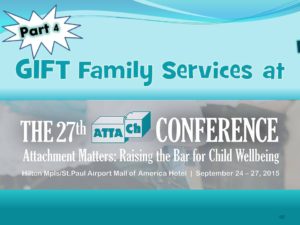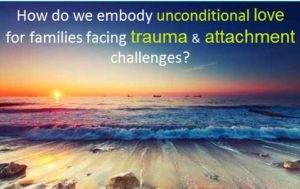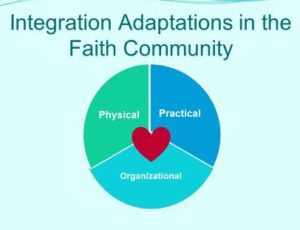 Final of a 4 part series examining the promise of faith communities as sources of healing and connection and GIFT coaches, Sally Ankerfelt and Susan David’s recent presentation at the 2015 ATTACh Conference in Minneapolis, Minnesota.
Final of a 4 part series examining the promise of faith communities as sources of healing and connection and GIFT coaches, Sally Ankerfelt and Susan David’s recent presentation at the 2015 ATTACh Conference in Minneapolis, Minnesota.
To bring you up to speed in this 4 Part series:
Week 1 discussed the promise of faith communities as healers and connectors, perhaps even more than we think.
Week 2 noted that faith communities at their best – through worship services, rituals, community outreach, even the physical presence of the building — are designed to improve areas of our lives and develop coherent healthy systems that foster emotional well-being.
Week 3 highlighted that despite the promise and potential of faith communities to heal and connect, it sometimes falls short because it seeks to influence its congregants. A paradigm shift from influence to integration is needed if congregants are to feel accepted and loved. This is especially true for those families dealing with inconsistency and trauma in their lives.
Today: How would it be for congregants to experience God‘s love through our relationship with them, by focusing on acceptance and belonging rather than influence?
 This week Susan and I offer some suggestions that can shift our faith communities away from influence and toward integration. These are specific integration adaptations that you can begin to discuss and work to implement with your own faith communities. This process may be a slow one but it need not happen overnight. Some suggestions may fit and others not but as coaches we know that even a small change can yield big results. In our opinion, continuing to educate the congregation on the need for acceptance and belonging as a way to heal and connect is vital. More importantly, a paradigm shift from influence to relationship will create a change that can take root and grow for years to come.
This week Susan and I offer some suggestions that can shift our faith communities away from influence and toward integration. These are specific integration adaptations that you can begin to discuss and work to implement with your own faith communities. This process may be a slow one but it need not happen overnight. Some suggestions may fit and others not but as coaches we know that even a small change can yield big results. In our opinion, continuing to educate the congregation on the need for acceptance and belonging as a way to heal and connect is vital. More importantly, a paradigm shift from influence to relationship will create a change that can take root and grow for years to come.
Faith Communities as a Source of Healing and Connection: What You Can Do list:
Physical:
- Set the tables in the fellowship hall in larger groupings to encourage “family style” eating.
- Have fellowship/coffee time take place closer to the worship space to encourage a fluid transition from one place to the next. If you can, have the coffee hour in different areas of the building to encourage others to participate. For example, if you have an elevator and there is space, have coffee available near the elevator, as well. Another example: occasionally have coffee and snacks in the education area, encouraging folks to go to the youth and “hang” in their “neck of the woods.”
- Rocking chair in sanctuary
- Quiet corner close to worship
- Increase entryway space if it’s small.
- Consider positioning of the pews. Is there any other way they can be configured to encourage community and relationship building?
- Consider calming colors on the walls.
- Look into putting windows in Sunday school rooms for safety.
- Have colorful plants outside the building.
- Temperature in the building
Practical:

- Provide a “fidgets cart” near the worship space where people young and old can reach in for a squeeze ball, stuffed animal, scented play-doh (there are homemade recipes on line that make a lesser-scented dough to which you can add aromatherapy oils), etc.
- Equip a pew with coloring crayons, paper, etc. directly on the pew/chair seat where a child can kneel on the floor and use the pew/chair as a table.
- Join hands for prayer time during worship.
- Provide brief explanations in the bulletin/order of service that set the various elements in the light of integration.
Examples: Confession and Forgiveness- Here we let go of our disappointments and failures of the week, trusting in God’s ability to ‘remember our sins no more’ so our here-and-now will not be clouded by our past and our future can be open to possibility.
Service of the Word – Hearing God’s love and guidance and listening to the Word, we find meaning in our experiences and move forward with faith and confidence.
Prayers- Together we lift up our joys and concerns. By doing so, we grow as a God-formed community and we are reminded that we are not alone.
Hymns- Singing Together reminds us that we all have a place in the choir; we all are important to the Body of Christ in our own, unique way. Christ’s body in this world is enhanced through our collective voices.
- Write liturgy for worship that reflects integration.
- Instead of “cafeteria style” congregational meals, try “family style” meals. It’s amazing what can happen when we pass the plate and have to ask our neighbor to pass the butter!
Organizational:
- Begin the conversation by asking and discerning:
- If the church can agree that they want to create a safe place and ministry for traumatized, excluded, special needs children.
- If so, who within the church can oversee this
- What resources will help meet those needs?
- Develop a mission statement that reflects the emphasis on relationship- building purely for the sake of people’s well-being.
- Invite all groups in the congregation to reflect on how their group supports the new mission statement of the church.
- Consider the qualifications/requirements for membership and removal of membership.
- In your constitution or by-laws, if you have a process for discipline that leads to removal of membership, consider developing a process for renewal of the relationship, whether it be reinstatement of active membership or some sort of maintaining of the relationship, even from afar. This may be as simple as a commitment of the congregation to pray for these members.
Education:
- -Safe and healthy congregation training
- -traditional Sunday school vs. relational Sunday school with an explicit emphasis on connection rather than curriculum
- -base curriculum on the five Intelligences, providing a variety of learning styles (rotational Sunday school sometimes works well)
- -Consider multigenerational Sunday school where children can receive more personal attention.
- -Put something like a “Trauma Tidbits” article in each newsletter that begins to educate the general membership.
- -Seek out as much information about a child as possible concerning learning and behavioral support needs, asking parent what is effective, what constitutes contacting them for support, etc. (i.e. screening interview)
- -Have an “angel helper” or trained “floater” or “mediator” who is knowledgeable in trauma behaviors and can help.
- -Buddy system
- -Special needs classes and rooms
- -Have a leadership and Sunday school leader training on the basics of trauma and the congregation’s philosophy (based on the mission statement) on behaviors and responses.
- -Create a plan for teachers so that they will feel both supported and equipped to respond to a behavior challenge.
Listen to our podcasts: Adoption Matters: Real People. Real Life. Real Talk and Essentials of Adoption Attuned Parenting
Read Books written by our coaches


